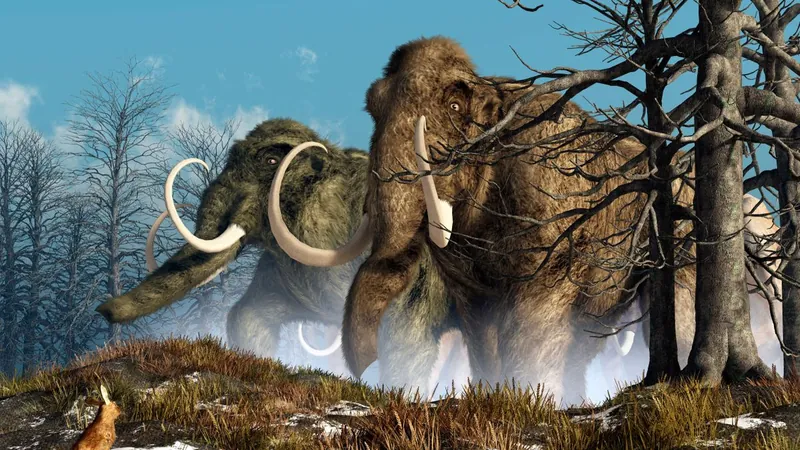
Could Pollen Allergies Have Caused the Woolly Mammoths' Extinction? Shocking New Research Reveals Surprising Links!
2024-09-25
Groundbreaking Study Reveals Potential Link Between Pollen Allergies and Woolly Mammoth Extinction
A groundbreaking study has emerged suggesting that soaring clouds of pollen in the mammoth steppe during the last Ice Age might have played a crucial role in the extinction of woolly mammoths. These large, furry giants, iconic of the Pleistocene epoch, faced an unexpected adversary: allergies triggered by a surge in vegetation resulting from global warming.
Research Findings
According to this research, which was published on August 27 in the journal Earth History and Biodiversity, a significant increase in pollen could have led to severe allergic reactions in mammoths. This, in turn, would have muddled their sense of smell—a vital tool for communication, reproduction, and survival. The study's authors propose that blocking their olfactory senses could have rendered these majestic creatures unable to find mates during the breeding season, ultimately leading to a catastrophic decline in their population and paving the way for extinction.
A Novel Explanation for Extinction
This theory posits a novel evolutionary mechanism behind the collapse of mammoth numbers, suggesting that as the landscape changed, so too did the challenges faced by these mammals. The study states: "One of the possible mechanisms for the extinction of animals during climate change could be a violation of the sense of smell due to the development of allergies when the flora changes."
Woolly Mammoths & Their Decline
Woolly mammoths (Mammuthus primigenius) roamed the Earth for nearly 2.6 million years, yet vanished from most regions around 10,000 years ago. A remnant population survived on Wrangel Island, off the northeastern coast of Russia, until just 4,000 years ago. Previous theories attributing their extinction include human hunting and drastic vegetation shifts, but the argument of allergic reactions presents a refreshing perspective in the ongoing debate over how these creatures met their end.
Impact of Impaired Olfactory Senses
The implications of such allergies would have far-reaching effects. Mammoths relied heavily on their keen sense of smell to navigate during migrations, evade predators, and locate food and mates. With their olfactory senses impaired—perhaps much like people experiencing severe hay fever—the mammoths may have effectively sealed their own fate.
Proposed Research Directions
To test the hypothesis that allergies exacerbated the mammoths' decline, researchers propose examining the stomach contents of preserved mammoth carcasses for specific plants and pollen known to cause allergic reactions. Interestingly, pollen has been found embedded in the mummified tissues of some specimens, holding potential clues to what could have triggered allergic responses.
Investigating Immune System Proteins
To delve deeper, the study advocates looking for immune system proteins, like immunoglobulin E (IgE), found in mammoth coprolites (fossilized dung). Tracking the presence of these proteins in ancient feces can help ascertain whether mammoths faced a historical hay fever epidemic. However, this area of research is still largely uncharted, as no prior studies have successfully identified IgE in ancient samples.
Skepticism in the Scientific Community
Despite these compelling findings, skepticism remains within the scientific community. Vincent Lynch, an evolutionary biologist and associate professor at the University at Buffalo, voiced reservations about the allergy theory’s validity, stating that it seems "pretty far out there" and is difficult to prove. He pointed out that while ancient DNA analysis has indicated a decline in the ability of the last mammoths to smell certain plants, many experts continue to believe that a combination of environmental shifts and human influence was more determinative in the species' extinction.
Continuing the Debate
As efforts to solve the mystery of the woolly mammoth's downfall continue, this intriguing study opens the door to exploring the potential impact of allergies on survival and extinction. Could we be overlooking critical factors in understanding how ancient beings adapted—or failed to adapt—to their changing worlds? The debate is far from over!



 Brasil (PT)
Brasil (PT)
 Canada (EN)
Canada (EN)
 Chile (ES)
Chile (ES)
 España (ES)
España (ES)
 France (FR)
France (FR)
 Hong Kong (EN)
Hong Kong (EN)
 Italia (IT)
Italia (IT)
 日本 (JA)
日本 (JA)
 Magyarország (HU)
Magyarország (HU)
 Norge (NO)
Norge (NO)
 Polska (PL)
Polska (PL)
 Schweiz (DE)
Schweiz (DE)
 Singapore (EN)
Singapore (EN)
 Sverige (SV)
Sverige (SV)
 Suomi (FI)
Suomi (FI)
 Türkiye (TR)
Türkiye (TR)